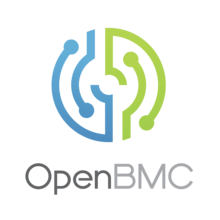OpenBMC
 | |
| Developer(s) | OpenBMC community |
|---|---|
| Initial release | 3 November 2015 |
| Stable release |
2.3
/ 12 July 2018 |
| Repository |
github |
| Written in | C++, Python |
| License | Apache License 2.0 |
| Website |
www |
The OpenBMC project is a Linux Foundation collaborative open-source project whose goal is to produce an open source implementation of the Baseboard Management Controllers (BMC) Firmware Stack.[1][2][3] OpenBMC is a Linux distribution for BMCs meant to work across heterogeneous systems that include enterprise, high-performance computing (HPC), telecommunications, and cloud-scale data centers.[3][4]
History
OpenBMC traces its origin to 2014, when four Facebook engineers at a Facebook hackathon event created the prototype version.[5] Founding organizations of the OpenBMC project are Microsoft, Intel, IBM, Google, and Facebook.[6][3]
Features
OpenBMC uses the Yocto Project as the underlying building and distribution generation framework.[7] OpenBMC uses D-Bus as an inter-process communication (IPC).[8][9]
Systems
- Google/Rackspace partnership
- Barreleye G2 / Zaius—two-socket server platform using POWER9 processors.[10][11]
- IBM
- Power Systems AC922 also "Witherspoon" or "Newell"—two-socket, 2U Accelerated Computing (AC) node using POWER9 processors with up to 6 Nvidia Volta GPUs.[12][13] AC922 was used in the U.S. Department of Energy's Sierra and Summit supercomputers.[14][15]
- Raptor Computing Systems / Raptor Engineering
- Talos II—two-socket workstation and development platform; available as 4U server, tower, or EATX mainboard.[16][17]
References
- ↑ "Projects - The Linux Foundation". The Linux Foundation. Retrieved 2018-03-19.
- ↑ "Power of Open(Source)BMC - OpenPOWER". OpenPOWER. 2016-02-02. Retrieved 2018-01-05.
- 1 2 3 "OpenBMC Project Community Comes Together at The Linux Foundation to Define Open Source Implementation of BMC Firmware Stack - The Linux Foundation". The Linux Foundation. 2018-03-19. Retrieved 2018-03-19.
- ↑ "The Firmware Stack Opens Up". EnterpriseTech. 2018-03-20. Retrieved 2018-03-21.
- ↑ "Introducing "OpenBMC": an open software framework for next-generation system management". Facebook Code. Retrieved 2018-01-05.
- ↑ "Home - OpenBMC". OpenBMC. Retrieved 2018-03-19.
- ↑ Wang, Xo (2017-05-22). "Developing on OpenBMC Under the hood with BitBake" (PDF). openpowerfoundation.org. Retrieved 2018-01-09.
- ↑ "OpenBMC, A Reference Firmware Stack - OpenPOWER". OpenPOWER. 2016-02-02. Retrieved 2018-01-09.
- ↑ Open Compute Project (2017-03-14), The OpenBMC Project, retrieved 2018-01-09
- ↑ "Introducing Zaius, Google and Rackspace's open server running IBM POWER9". Google Cloud Platform Blog. Retrieved 2018-01-05.
- ↑ PyCon Australia (2016-08-15), OpenBMC: Boot your server with Python, retrieved 2018-01-09
- ↑ "IBM Power System AC922 - Details - United States". www.ibm.com. 2018-01-05. Retrieved 2018-01-05.
- ↑ Bader, David (2017-11-15). "The @IBM Power9 "Newell" compute node is the world's most accelerated node with next-gen NVLink to @NVIDIA #GPUs". @Prof_DavidBader. Retrieved 2018-01-05.
- ↑ "Details Emerge On "Summit" Power Tesla AI Supercomputer". The Next Platform. 2016-11-20. Retrieved 2018-03-27.
- ↑ "The Roadmap Ahead For Exascale HPC In The US". The Next Platform. 2018-03-06. Retrieved 2018-03-27.
- ↑ GmbH, finanzen.net. "A High Performance, Open, and Secure Alternative to X86 Computing". markets.businessinsider.com. Retrieved 2018-01-05.
- ↑ 2018, (c) Raptor Engineering, LLC 2009 -. "Raptor Computing Systems::TL2WK2 Intro". www.raptorcs.com. Retrieved 2018-01-05.